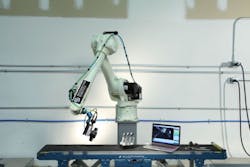Smart camera and vision algorithms combine for robotic vision guidance platform
When a larger automotive OEM required robotic guidance in a smaller, more cost-effective form factor in an assembly process, Recognition Robotics developed an improved version of its previously-released robotic guidance product.
In 2012, Recognition Robotics introduced its Robeye solution for robot guidance that was designed to mimic the way that humans see. The system uses an industrial camera attached to a robot arm to capture images of part that the robot will be guiding to, and a separate industrial computer processes the images and communicates with the robot’s controller.
Recently, an automotive customer required a system with a smaller footprint, lower cost, and a simpler setup and operation. To provide vision guidance for a robotic arm being used to derack automotive body panels and place them onto a vehicle in the body-in-white part of the vehicle assembly process, Recognition Robotics partnered with ADLINK to develop an improved version of Robeye called Robeye All-In-One or RAIO.
The RAIO camera leverages an ADLINK NEON-1020 smart camera, which features the 2 MPixel CMV2000 CMOS image sensor from ams Sensors Belgium (CMOSIS). The sensor offers a 5.5 µm pixel size and reaches a frame rate of 120 fps. ADLINK’s smart camera also features an Intel Atom Quad Core processor E3845 1.91GHz, an FPGA co-processor, and runs on Windows or Linux. This architecture, according to ADLINK, reduced the footprint of the Robeye product and provided an IP67-rated "self-contained visual recognition and guidance system."
Running on the RAIO camera, Recognition Robotics’ vision algorithms were applied to the robotic vision guidance system. The algorithms, according to Recognition Robotics, process images similar to how the human visual cortex functions. From a single 2D image, the system can recognize a part and return the X, Y, Z, Rx, Ry, and Rz location information about the orientation of the part within the robot’s user frame. With this data, the robot is then able to update a preprogrammed path with the corrected offset data of that parts current location in space.
"The algorithms are based on the human cognitive ability to recognize objects. When I developed these algorithms, I was mimicking the human visual cortex. We’ve used knowledge about human brain function, the point of view of the human eye, and put this into the software realm," Dr Simon Melikian, CEO, Recognition Robotics.
Recognition Robotic’s RAIO is a lightweight solution that can be mounted directly onto the robotic arm, and because it is a self-contained system, it is easy to remotely interface the RAIO and the robot controller for object teaching, configuration, and execution, according to ADLINK. This capability allows for remote programming and monitoring of multiple RAIO work cells across the manufacturing floor network.
"ADLINK is very well known in the industry. They have been very flexible with us, they worked with us to get exactly what we needed out of an embedded sensor. There were specific features that we talked to ADLINK about, and they made sure we received exactly what we were looking for," said Bradley Vargo, Robotics Guidance Engineer, Recognition Robotics.
View more information on Recognition Robotics.
View more information on ADLINK.
Share your vision-related news by contacting James Carroll, Senior Web Editor, Vision Systems Design
To receive news like this in your inbox, click here.
Join our LinkedIn group | Like us on Facebook | Follow us on Twitter
About the Author

James Carroll
Former VSD Editor James Carroll joined the team 2013. Carroll covered machine vision and imaging from numerous angles, including application stories, industry news, market updates, and new products. In addition to writing and editing articles, Carroll managed the Innovators Awards program and webcasts.
